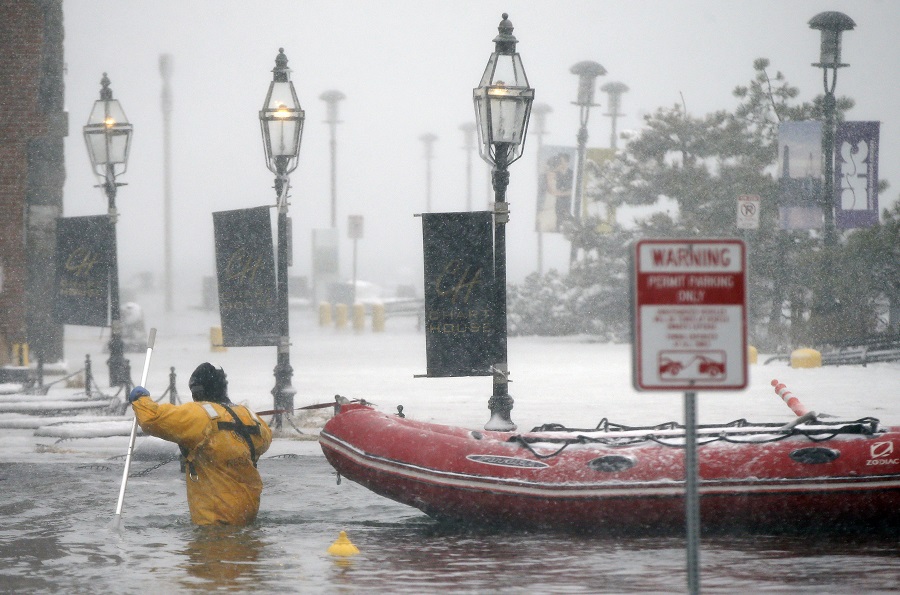Severe winter weather slams the East Coast, causing storm surge in Massachusetts
A severe winter storm enveloped the East Coast on Thursday, affecting weather across the coast from southern Florida and Georgia, up to Maine. Tragically, the storm even caused the death of three individuals in North Carolina. Heavy snowfall blanketed much of the Northeast, with totals ranging from 13.9 inches in Providence, Rhode Island to 9 inches in Manhattan.
The “bomb cyclone” underwent “bombogenesis,” measured as a drop-in pressure at a rate of 53 millibars in 21 hours. This doubled the rate of 24 millibars per 24 hours necessary to be deemed a “bomb.” The storm also significantly impacted air travel, causing the cancellation of over 5,300 flights going into Friday and the delay of at least 2,000 others.
The combination of high tides and blizzard conditions created particularly dangerous situations for residents in Massachusetts and Boston. Snowfall ranged from a little over a foot at Boston Logan Airport to nearly 17 inches in Taunton. On Thursday afternoon, Massachusetts Emergency Management Agency reported that 20,592 people had lost power; fortunately, that number had lowered to only 11,000 within two and a half hours.

Boston suffered from the largest tide swell since a nor’easter in 1978. The 15-foot water levels resulted from a high astronomical tide of about 12 feet and a storm surge of about 3 feet. In a public address, Boston Mayor Marty Walsh reported that flooding had occurred in Seaport, Charlestown, the North End, East Boston, and Dorchester, and caused the closure of the Aquarium Station Metro stop. Healthcare services were also heavily affected; police were requisitioned to transport medical personnel to and from Hospitals, and in Brighton, a senior complex was forced to evacuate 89 people to hotels. Drivers became trapped in cars until they were rescued by the fire department, while other vehicles were seen floating down the street on the slush. A break of a seawall in Scituate forced 26 people to evacuate their homes; another 20 people in Marshfield were also forced to evacuate their homes.
This storm demonstrates the risks of flooding at high tide, especially as sea levels continue to rise as a result of climate change. During Hurricane Sandy, Boston was fortunate that Sandy missed high tide by five and a half hours, avoiding flooding that could have engulfed 6.6% of the city. The combination of high tides, extreme weathers, and development along the coast means that future flooding poses greater threats to infrastructure and commerce. Specific pieces of critical infrastructure at risk include the South Boston Power Complex, which is the central power hub for the MBTA subway’s energy system. Also located along the waterfront is the Mystic Power Generating Station which helps power Greater Boston, and provides vital energy resources for homes, hospitals, and schools across the region. With temperatures once again expected to be in the single digits over the weekend, concerns remain over the safety of the roads, as icy conditions continue to complicate recovery efforts.
The risks from flooding can be seen in detail through data visualization tools from Sasaki or the Climate Ready Boston.
Sources and Further Reading:
- ‘Bomb Cyclone’: Snow and Bitter Cold Blast the Northeast – New York Times
- Snowstorm floods Boston Harbor and coastal Massachusetts streets with icy water – ABC News
- Roads, cars submerged: Storm raged with snow, floods – Boston Globe
- ‘Bomb cyclone’ triggers Boston flooding panic, high tides trapping drivers – Fox News
- Massive flooding up and down coast as storm drives epic high tide – Boston Herald
- ‘Bomb cyclone’ moves north, bringing frigid temperatures and coastal flooding – LA Times
- Snow tapers off but Northeast still dealing with cold, icy streets – CNN
- Storm fills region with an icy flood – Boston Herald
- Sea Change Boston – Sasaki
- You Can Explore Boston Sea Level Rise And Flooding Scenarios With This City Map – WBUR
- Preparing for the Rising Tide – Boston Harbor Association
- South Boston – City of Boston, Climate Ready Boston
- Charlestown – City of Boston, Climate Ready Boston
